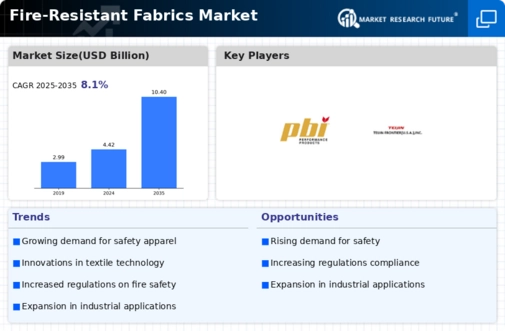Market Share
Fire Resistant Fabrics Market Share Analysis
In the competitive landscape of the Fire Resistant Fabrics Market, companies employ various market share positioning strategies to carve out their niche and gain a competitive edge. One prevalent strategy is differentiation, where companies focus on unique features or benefits of their fire-resistant fabrics to stand out. This could involve offering fabrics with superior fire resistance, durability, comfort, or environmental sustainability compared to competitors. By highlighting these distinctive qualities, companies attract customers who prioritize specific attributes in their purchase decisions.
The development of environment-friendly fire resistant fabrics, with low toxicity, and smoke, is anticipated to be the major opportunity to investment over the forecast years.
Another key strategy is cost leadership, wherein companies strive to offer fire-resistant fabrics at lower prices compared to competitors while maintaining acceptable quality standards. This approach appeals to price-sensitive customers and allows companies to capture a larger market share by catering to budget-conscious segments. Implementing efficient production processes, optimizing supply chains, and leveraging economies of scale are common tactics to achieve cost leadership and remain profitable in the market.
Companies also focus on market segmentation to target specific customer segments effectively. This involves dividing the market based on factors such as industry verticals, application requirements, or geographic regions and tailoring their marketing efforts and product offerings accordingly. By understanding the distinct needs and preferences of different segments, companies can better position their fire-resistant fabrics to meet specific customer demands, thereby enhancing their market share within targeted segments.
Furthermore, partnerships and collaborations play a crucial role in market share positioning strategies. Companies often form strategic alliances with suppliers, distributors, or industry associations to expand their reach and access new markets. Collaborating with complementary businesses can also lead to the development of innovative products or solutions that address evolving customer needs more effectively. By leveraging the expertise and resources of partners, companies can strengthen their market position and gain a competitive advantage.
In addition to these strategies, continuous innovation is essential for maintaining market share in the fire-resistant fabrics market. Companies invest in research and development to improve existing products, develop new technologies, or explore alternative materials that enhance the performance or functionality of fire-resistant fabrics. By staying ahead of technological advancements and industry trends, companies can differentiate their offerings and retain customer loyalty, thereby safeguarding their market share against competitors.
Moreover, effective marketing and branding are vital for establishing a strong market presence and influencing customer perceptions. Companies invest in building brand awareness, positioning their fire-resistant fabrics as premium or value-oriented solutions, and communicating their unique selling propositions through various channels such as advertising, public relations, and digital marketing. A compelling brand image helps companies differentiate themselves from competitors and create emotional connections with customers, driving preference and loyalty in the market.
Finally, customer service and support play a crucial role in sustaining market share. Companies strive to provide exceptional pre-sales and post-sales support, including technical assistance, customization options, and prompt resolution of customer inquiries or concerns. By delivering a superior customer experience, companies can foster long-term relationships with clients, encourage repeat purchases, and generate positive word-of-mouth referrals, ultimately strengthening their market position in the fire-resistant fabrics industry.






Leave a Comment